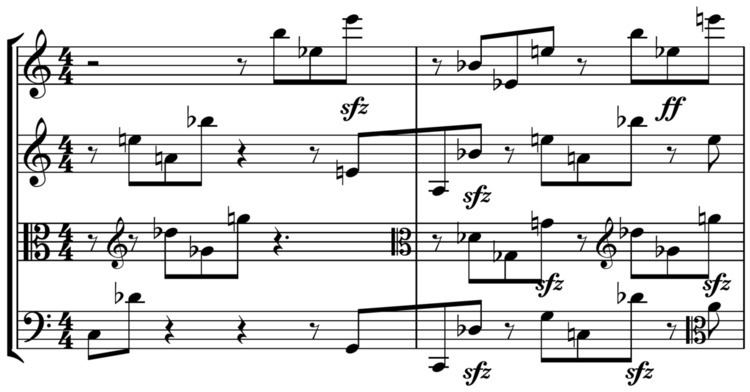 | ||
The Austrian composer Arnold Schoenberg published four string quartets, distributed over his lifetime. These were the String Quartet No. 1 in D minor, Op. 7 (1905), String Quartet No. 2 in F sharp minor, Op. 10 (1908), String Quartet No. 3, Op. 30 (1927), and the String Quartet No. 4, Op. 37 (1936).
Contents
- String Quartet in D major
- String Quartet No 1
- String Quartet No 2
- Text
- String Quartet No 3
- String Quartet No 4
- References
In addition to these, he wrote several other works for string quartet which were not published. The most notable was his early String Quartet in D major (1897). There was also a Presto in C major (c. 1895),[1] a Scherzo in F major (1897),[2] and later a Four-part Mirror Canon in A major (c. 1933).[3] Finally, several string quartets exist in fragmentary form. These include String Quartet in F major (before 1897), String Quartet in D minor (1904), String Quartet in C major (after 1904), String Quartet Movement (1926), String Quartet (1926), String Quartet in C major (after 1927) and String Quartet No. 5 (1949).
Schoenberg also wrote a Concerto for String Quartet and Orchestra in B-flat major (1933): a recomposition of a work by the Baroque composer George Frideric Handel.
String Quartet in D major
This string quartet in four movements is Schoenberg's earliest extant work of large scale: average duration of recorded performances is about 27 minutes. Completed in 1897, it was premiered privately on March 17, 1898, and publicly later that same year on December 20 in Vienna. It was published posthumously in 1966 (Faber Music, London).
Schoenberg's friend Alexander von Zemlinsky gave him much advice and criticism during the composition of this work. Zemlinsky even showed an early draft of it to Johannes Brahms, whom Schoenberg very much admired. It was given the old master's approval.[4]
- Allegro molto
- Intermezzo (Andantino grazioso)
- Theme and Variations (Andante con moto)
- Allegro
The original second movement was the Scherzo in F which now exists as a separate piece. Schoenberg substituted the Intermezzo at Zemlinsky's suggestion.
String Quartet No. 1
A large work consisting of one movement which lasts longer than 45 minutes, Schoenberg's First String Quartet was his first assured masterpiece, and it was the real beginning of his reputation as a composer. Begun in the summer of 1904 and completed in September 1905, this quartet is remarkable for its density and intensity of orchestration with only four instruments. Unlike his later works, this work is tonal, bearing the key of D minor, though it stretches this to its limit with the thoroughly extended tonality of late Romantic music, such as the quartal harmony pictured at right. It also carries a small collection of themes which appear again and again in many different guises. Besides his extension of tonality and tight motivic structure, Schoenberg makes use of another innovation, which he called "musical prose." Instead of balanced phrase structures typical of string quartet writing up to that period, he favored asymmetrical phrases that build themselves into larger cohesive groups.
According to Schoenberg, when he showed the score to Gustav Mahler, the composer exclaimed: "I have conducted the most difficult scores of Wagner; I have written complicated music myself in scores of up to thirty staves and more; yet here is a score of not more than four staves, and I am unable to read them." [5]
String Quartet No. 2
This work in four movements was written during a very emotional time in Schoenberg's life. Though it bears the dedication "to my wife", it was written during Mathilde Schoenberg's affair with their friend and neighbour, artist Richard Gerstl, in 1908.
The third and fourth movements are quite unusual for a string quartet, as they also include a soprano singer, Marie Gutheil-Schoder, using poetry written by Stefan George.
"I was inspired by poems of Stefan George, the German poet, to compose music to some of his poems and, surprisingly, without any expectation on my part, these songs showed a style quite different from everything I had written before." - Arnold Schoenberg (1937)
- Mäßig (Moderate), F sharp minor
- Sehr rasch (Very brisk), D minor
- "Litanei", langsam ("Litany", slow), E flat minor
- "Entrückung", sehr langsam ("Rapture", very slow), No key
Text
The latter two movements of the Second String Quartet are set to poems from Stefan George's collection Der siebente Ring (The Seventh Ring), which was published in 1907.
String Quartet No. 3
Arnold Schoenberg's Third String Quartet dates from 1927, after he had worked out the basic principles of his twelve-tone technique. Schoenberg had followed the "fundamental classicistic procedure" by modeling this work on Schubert's String Quartet in A minor, Op. 29, without intending in any way to recall Schubert's composition.[6] There is evidence that Schoenberg regarded his 12-tone sets—independent of rhythm and register—as motivic in the commonly understood sense, and this has been demonstrated with particular reference to the second movement of this quartet.[7]
The piece was commissioned by Elizabeth Sprague Coolidge on March 2, 1927, though the work had already been completed by this time, and its première was given in Vienna on September 19, 1927, by the Kolisch Quartet.
- Moderato
- Theme and Variations (Adagio)
- Intermezzo (Allegro moderato)
- Rondo (Molto moderato)
String Quartet No. 4
The Fourth String Quartet of 1936 is very much representative of Schoenberg's late style. The slow movement opens with a long unison recitative in all four instruments while the finale has the character of a march, similar to the last movement of Schoenberg's Violin Concerto written about the same time.
- Allegro molto, Energico
- Comodo
- Largo
- Allegro
